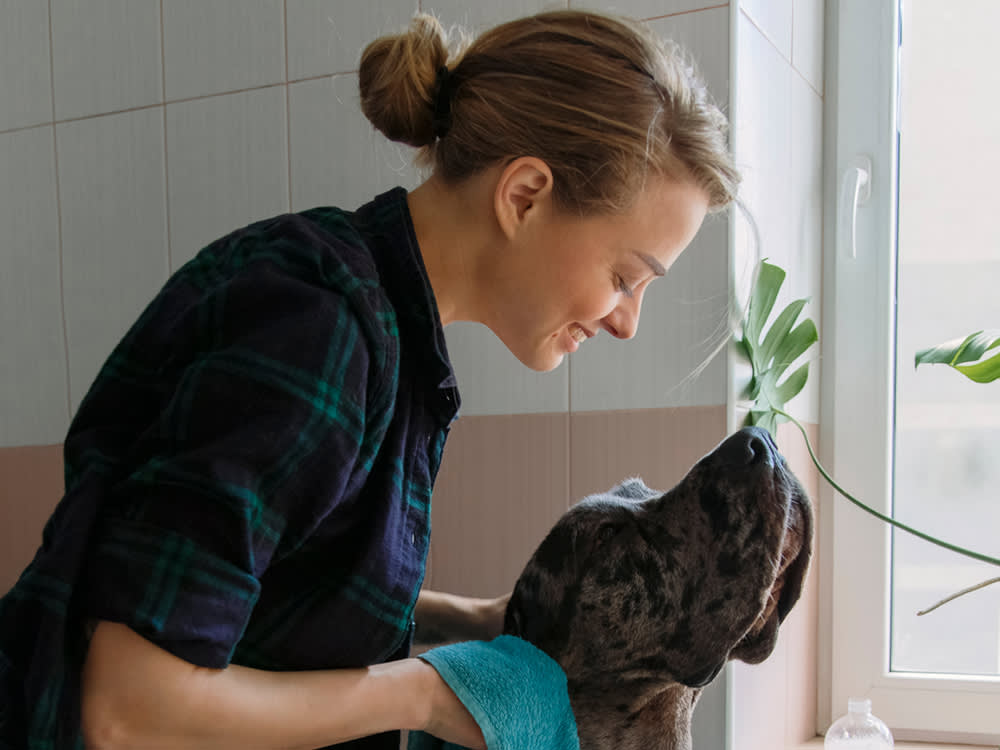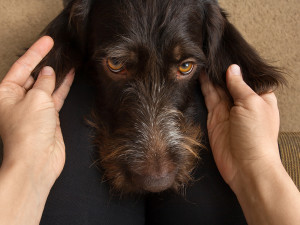Should You Clean Your Dog’s Ears at Home?
Heed all those cautionary tales about Q-tips.
In This Article:
Dog Ear-Cleaning Tools How to Clean Your Dog’s Ears How Often Should I Clean My Dog’s Ears Dog Ear-Cleaning Solutions Preventing Ear Infections In Dogs When to Avoid At-Home Ear Cleaning
Keeping your dog’s ears clean prevents painful infections. Take a gentle approach using appropriate products following these tips to establish an effective ear-cleaning routine:
Step one: Study your dog’s ears.
Learn your dog's normal ear anatomy and appearance when healthy. Check externally and internally every one to two weeks for redness, discharge, strong odors, head shaking, or dark buildup — all indicating a need for cleaning.
Step two: get the right products.
Purchase a veterinarian-recommended ear wash and cotton rounds designed specifically for dogs. Never use peroxide, alcohol, or human products. Review label instructions for guidance.
Step three: Make it fun.
Create positive associations with handling their ears and head by providing high-value treats anytime you inspect or touch their ears. Over multiple occasions, dogs learn to accept and expect enjoyable ear handling.
How much do you spend on your pet per year?
Step four: Use products gently.
When washing, apply the minimum volume of solution needed to moisten the inner ear canal to loosen debris. Massage gently only on outer surfaces to distribute the solution. Then, thoroughly clean the area afterward using cotton soaked in clean water.
Step five: create a cleaning schedule.
Establish a consistent schedule for ear cleaning depending on your dog’s breed, ear shape, lifestyle, and tendency towards building wax or debris. Some dogs need biweekly cleanings, while others only require once a month or less.
Step six: avoid injury.
Never insert cotton swabs, sticks, or other objects into the vertical ear canal to avoid injury or pushing debris deeper inside.
What should I use to clean my dog’s ears?
To care for your dog’s ears at home, use an ear cleaning solution that is made for dogs. Dogs’ ears have a different pH level than human ears, so it’s not recommended to use human ear cleaning products to clean a dog’s ears. Most routine ear cleaners available from your vet’s office will have ingredients that help to:
Remove dead cells
Break up waxy debris that can harbor bacteria or yeast
Maintain a normal pH
Dry the ears
Basic tools
You don’t need a lot of tools to clean your dog’s ears at home. This can be messy work, so find an easy-to-clean surface or put a blanket or towel under your dog.
Ear wash solution
Cotton balls
Q-tips (if used with caution)
How to clean your dog’s ears
OK, how exactly do you clean your dog’s ears? Let’s be honest: Most dogs dislike having their ears cleaned, so it’s important to practice with your pup before attempting to do any actual cleaning. Some dogs may happily sit in your lap, but others could require restraint. The instructions below assume the right ear is being cleaned. For detailed photos and additional instructions, see this post from WSUopens in new tab.
1. Get in position.
With your dog lying down on their chest, you should stand on the opposite side of the ear you are cleaning.
2. Massage your dog.
If your dog enjoys it, gently massage your dog’s neck and ears to get them relaxed.
3. Wrap your arms in a hug around your dog.
Rest your right arm across your dog’s shoulder. Then, as if you are giving them a hug, wrap your left arm under and around their neck. If your dog tries to stand, lean your upper body over their shoulders to prevent them from getting up. If your dog is too wiggly, you could try laying them on their side.
4. Pull back the ear flap.
Use the left hand’s fingertips to push the ear flap back and up to expose the inner surface of the ear.
5. Squeeze the ear wash solution into the ear canal.
Holding the bottle with your right hand, add a few drops of ear wash to the inside of the ear flap. Try to avoid touching the tip of the bottle to the ear to prevent contamination. Never force the tip of the bottle into the ear canal; that could damage the eardrum.
6. Let your dog shake their head.
As you can imagine, most dogs will shake their head once the cleaning solution is in their ear, shaking out much of the solution. That’s fine and expected.
7. Gently massage your dog’s ears.
Your dog will probably like this part. Massage the base of the ear to distribute the wash solution throughout the ear canal.
8. Swab with cotton balls.
Use cotton balls to remove discharge from the inner side of the ear flap.
9. Swab with Q-tips (optional).
You can use Q-tips to gently clean the grooves on the inner side of the ear flap, but never stick Q-Ttps into the ear any further than you can easily see. Inserting a Q-tip too far can pack wax and other debris further into the ear canal or, worse, rupture the eardrum. This would lead to bigger problems or prevent medications from penetrating deeper parts of the ear canal. Remember, you wouldn’t do it to your own ear, so don’t do it to your dog’s.
How often should I clean my dog’s ears?
Most dogs with healthy ears don’t require routine ear cleaning; nature takes care of things. Regular ear cleaning may be recommended for some dogs that swim very frequently, have allergies, or have a history of ear infections. The required frequency of cleaning a dog’s ears increases when there is an active infection. Many dogs with ear issues benefit from having their ears cleaned once or twice a week, but this varies from dog to dog based on how much wax and discharge their ears produce.
If your dog’s ears look inflamed or infected, talk to your vet before putting anything into them. Some infections can cause ruptured ear drums. Putting certain cleaning products or medications into an ear with a damaged ear drum can result in deafness, loss of balance, abnormal eye movements, or other issues.
How can I make my dog cooperate during ear cleaning?
Managing to clean a dog’s ears can be a big challenge for some dog parents. Small dogs can be very wiggly and elusive, while larger dogs may be strong enough to just stand up and walk away. The best way to get your dog to cooperate for an ear cleaning is to make it as positive an experience as possible for them.
Work on getting your dog used to being in the position for cleaning first. Reward them with treats and pets for laying calmly with you where you plan to do the cleaning. Once they’re used to that, begin holding them as you would for ear cleaning, but releasing them once they’re relaxed and calm for this. Then introduce petting, touching, and moving their ear flaps. Move gradually through the steps over a period of days, making sure to make it as stress-free and rewarding as possible for them before introducing the actual ear cleaning.
Dog ear-cleaning solutions
Most veterinarians carry ear cleaning solutions, so consult your veterinarian for a safe, vet-approved ear wash. If they don’t have them in stock, your veterinarian will be able to provide you with alternative recommendations for your dog. Due to the possibility of ear infections, it’s best not to use a DIY ear-washing solution without consulting your vet first. Ears are incredibly sensitive and require mild solutions, so don’t use vinegar, hydrogen peroxide, or alcohol on your dog’s ears, which could cause painful irritation.
If you need to apply prescription ear medication provided by your vet, you’ll find that ear medications are most effective when placed in a clean ear rather than applied on top of ear wax or other debris. Follow your veterinarian’s instructions on how to apply and discuss whether your dog needs their ears professionally cleaned before you apply medications to them.
Preventing ear infections
Routine cleaning of your dog’s ears can be a powerful tool in preventing ear infections for those dogs most susceptible to it. An interesting note is that dogs have many more ear problems than cats. Dogs with heavy, floppy ears tend to have the most issues with ear infections. Certain dog breeds with lots of hair in and around the ear canal may also be more prone to developing ear infections.
Besides genetic factors, lifestyle also plays a role. Dogs who spend lots of time in the water may be more prone to developing ear infections, among other conditions like swimmer’s tail. Veterinarians also find that dogs with skin allergies may experience ear infections as part of the allergy. Making sure your dog’s ears are dry after water activities and managing their allergy symptoms with your vet can help to prevent ear infections.
Airflow is important to maintaining a healthy ear. Having lots of fur at the ear canal opening reduces airflow into the ear, so talk with your veterinarian if you think this might be an issue. Grooming can help improve this airflow.
When you shouldn’t do at-home ear cleaning
Ask your veterinarian if at-home ear cleaning would be helpful for your dog. Your veterinarian may recommend a thorough ear exam under sedation if they find problems with your dog’s ears beyond mild build-up. There are several reasons why a vet may make this recommendation:
A dog that will not allow thorough cleaning of heavy build-up while awake.
Suspected foreign body such as plant material (think: foxtails) inside the ear canal.
The veterinarian needs to collect samples from the ear for cytology or culture.
Ear infection is suspected.
Signs of possible ear infection in dogs include head shaking, ear scratching, redness, scabs, rash, crust, moisture, or other discharge in the ear canal, along with any strong odor. If your dog typically enjoys having their ears rubbed and suddenly pulls away or shows signs of pain, reach out to your veterinarian before attempting at home.
If you suspect your dog has an ear infection or if you feel uncomfortable cleaning your dog’s ears, seek veterinarian assistance. This information is not meant to be a substitute for veterinary care. Always follow the instructions provided by your veterinarian.
FAQs (People also ask):
How do I inspect my dog’s ears before cleaning?
Take a look at your dog’s ears by lifting the ear flaps (if they have floppy ears) and checking for discharge, odor, redness, or evidence of bleeding. Pointy-eared dogs are easier to monitor but should still be watched for problems.
Can I use homemade solutions like vinegar or hydrogen peroxide?
Using homemade solutions is not recommended because they can be harsh for a dog’s ears. Ear cleaning solutions made for dogs provide better cleaning and are less likely to burn or cause irritation.
What should dog ear wax look like?
Dog ear wax can normally range from pale yellow to light brown in color. Colors that appear greenish, black, dark red, or dark brown could indicate a problem like an ear infection or ear mites.
How do I know if my dog has an ear infection?
Common signs of an ear infection include head shaking, scratching at the ears, ear odor, increased discharge, pain around the ears, and redness of the ear canal. See your vet to determine if an infection is present and the underlying cause for it.










